PPC
Everything You Need to Know

When Google first introduced its Performance Max campaigns, it set off with a goal to make advertising across all of its properties (search, display, video, Discover, Gmail, and Maps) simple to manage within one campaign type.
Getting started with Performance Max campaigns is easy. Optimizing Performance Max campaigns? Well, that can be much more difficult.
Luckily, Google recently released a new beta feature for Performance Max campaigns called “search themes” designed to help advertisers better target their ads with a similar keyword-inspired approach that most advertisers are used to. In this article, we’re covering what search themes are, how to create them, and how to use them the right way.
Table of contents
What are search themes for Performance Max campaigns?
Google’s fully automated campaign type allows you to control very little. You can improve your different ad assets, website, product feed, and even provide audience signals to better target your Performance Max campaigns–but that’s still very lacking to the rest of Google Ad’s targeting options. Especially for most of us who are used to running search campaigns with robust keyword targeting options–running search ads through Performance Max campaigns can be a frustrating experience.
Search themes are a new feature that allows advertisers to provide some additional context and signals to Google to help target their Performance Max campaigns. Advertisers can provide search themes to Google to share how they expect their customers to search for their products or services.
With this additional context, Google can consider these search themes as new signals to target audiences based on their search behavior. Google may use these search themes to better refine their Performance Max campaign targets, or to reach new relevant placements on the SERP and beyond.
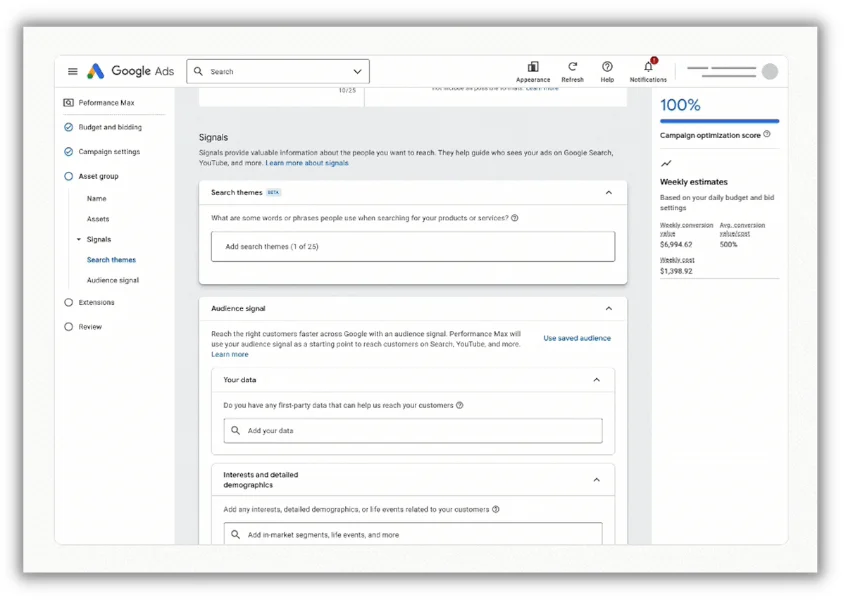
Search themes is an optional feature in Performance Max campaigns. However, we’ve seen time and time again that Performance Max campaigns perform the best when they’re given better signals, so I’d encourage you to provide Google with at least a few search themes to give Google enough signals to optimize your campaigns with. Advertisers can provide up to 25 search themes per asset group.
🛑 Worried you’re wasting spend in Google Ads? Find out with a free, instant audit >> Google Ads Performance Grader
Search themes are set to replace custom segments based on search intent
Within Google’s most recent announcement introducing Search themes, Google also shares that they’ll be ending support for custom segments based on past search activity within Performance Max campaigns in early 2024. These audience segments will automatically be upgraded to Search Themes.
Previously known as “Custom Intent” audiences, these audiences used very similar signals to the new Search themes, effectively targeting people based on their past searches on Google. Since this audience signal is so similar to Google’s new “search themes” beta, the automatic upgrade in 2024 is unlikely to negatively impact campaign performance. Hopefully, it streamlines workflows and makes signal management easier for advertisers.
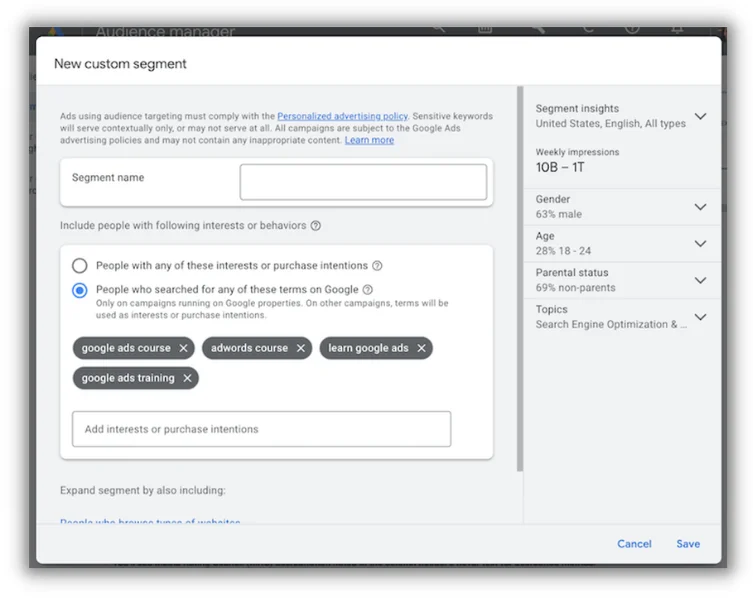

Custom segments based on previous search activities will continue to function uninterrupted in other campaign types, including search campaigns. Additionally, all other custom segments based on other attributes (affinities, interests, apps, URLs, and demographics) will continue to exist in Performance Max campaigns and serve as valuable audience signals for Google’s ongoing optimization.
How do I create search themes in my Performance Max campaigns?
Search themes is a new feature in beta and may not currently be available to all advertisers, however, Google is expected to release it to more advertisers throughout the rest of the year.
- To add search themes to your Performance Max campaigns, simply:
Select a Performance Max campaign. - Select an Asset group. Each asset group can have different audience signals and search themes.
- Next to your ad assets in your Asset group, you’ll notice a card for “Signals.” Select the pencil icon to edit your signals.


- Here, you’ll see the new Search Themes beta. Advertisers can add up to 25 unique search themes per asset group to help improve the signals of their Performance Max campaign. Each search theme must be shorter than 80 characters in length.


- Be sure to scroll to the bottom of the page and save your changes to your Asset group signals!
Search themes can also be edited or removed at any time from this menu. Once changed or removed, Google will no longer use that signal when targeting its ads to an audience.
But removing a search theme isn’t like removing a keyword or adding a negative keyword in a search campaign–Google may continue to serve ads on similar search queries if it believes it’s relevant to users. However, Search themes will still respect any brand exclusions or account-level negative keywords that you’ve implemented. If you want to prevent your Performance Max campaigns from serving for irrelevant and unwanted traffic–you’ll still want to use those tools!
⚡️ Is your Google Ads account set up for success? Download now >> The Last Guide to Google Ads Account Structure You’ll Ever Need
How will search themes in Performance Max campaigns affect my search ads?
Performance Max campaigns and traditional search campaigns are both eligible to serve ads on the Google SERP and search partner engines. Advertisers who are running both Performance Max campaigns and search campaigns will often run into issues where both campaign types are targeting the same searches and risk serving different ad experiences to the same searches or struggle to manage the two campaigns synchronously. Using search themes in Performance Max may ease some of those issues for advertisers.
In these issues where multiple campaigns or ad groups are eligible to serve an ad to a searcher, Google prioritizes exact match keywords that are identical to the search above all others. Google’s new Search themes are treated as a lower priority, equal to that of phrase and broad match keywords.
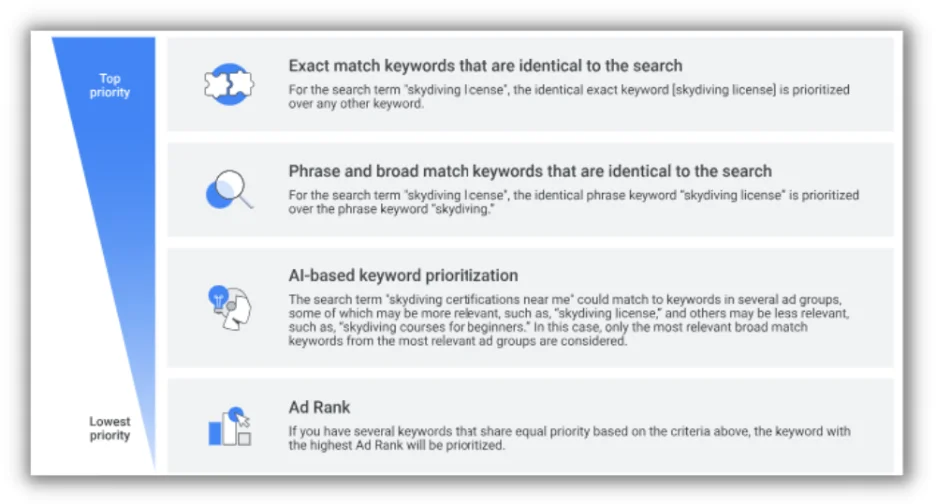

Your exact match keywords in your search campaigns will also take priority over your Performance Max campaigns–so they’re still a must-have for advertisers now.
Best practices for using search themes in Performance Max campaigns
While nearly all additional data and context will help these Performance Max campaigns continue to improve, advertisers can make the most of search themes in their accounts by following a few tips.
1. Use search themes to provide information missing from your landing pages
If you’ve just launched a new product or website, your landing page may not include every single feature, benefit, use, value, and detail that a searcher might consider–and that’s okay! In fact, a clean and simplified landing page may help more people convert on your site.
If Google can’t find that context from your landing page–fret not. Liberally use search themes in your Performance Max campaigns to provide those extra signals to Google so it best understands what your audience may be looking for and can optimize its placements accordingly.
2. Be direct—especially when using ulterior brand messaging
What does direct mean? Well, consider the well-known fast-casual restaurant Hooters. If you were to just read their website or its descriptions, you might mistakenly describe their business as a chicken wings restaurant. But we all know that there are a few missing keywords in that description that serve their core value prop and distinguish them from similar competitors.
There’s nothing shameful about having hidden benefits that you don’t expressly convey within your ads or on your website. Maybe your hotel welcomes all but is known best for catering to families, tourists, a religious community, foreign-speaking nationals, or people recovering from a nearby medical procedure, or maybe it has a history of being haunted. You might not want to explicitly write some of that on your website or within your ads—but if someone is specifically looking for a paranormal vacation a Sabbath-friendly accommodation, or a sanctuary nearby their treatment, advertisers can use search themes to better signal their ads within a Performance Max campaign.
3. Maximize your varied and unique search themes
Advertisers are allowed up to 25 search themes within each asset group. Generally, the more signals you can provide to Google, the better your Performance Max campaigns will perform. However, quantity isn’t the only factor in quality.
Treat your search themes similar to how you’d treat broad match keywords in your search campaigns–make sure that they aren’t effectively the same signal. For example, the search themes “car” and “automobile” will reach the exact same audience and won’t improve performance incrementally.
4. Consider competitor terms as search themes
Especially if you’re a new brand on the market–this will help Google more quickly understand who your prospects are currently searching for. Google allows bidding on your competitors’ keywords (in many cases) within your search campaigns and includes your competitor’s brands and product names as search themes. Before implementing this strategy, however, make sure that you understand any local laws or regulations about how you can advertise on competitor brands and trademarks.
5. Use traditional search campaigns alongside your Performance Max campaigns
Search themes are a powerful signal to add to your Performance Max campaigns. Even though your Performance Max campaigns will automatically target the search network, don’t neglect the importance of your search campaigns on their own.
Use search themes within your Performance Max campaigns to find new placements and scale incremental traffic and continue to apply that found insight to your search campaigns. As you build your search campaigns, be sure to incorporate exact match keywords so that they take priority over your Performance Max search theme signals, and you can continue to target, optimize, and refine your newfound traffic.
Use search themes the right way in Performance Max campaigns
Google’s new search themes beta will help advertisers share their human expertise and provide better signals to their machine learning powered Performance Max campaigns. Search themes gives you a little more control over your Performance Max campaigns, making them more effective and tailored for your audience.
PPC
How the TikTok Algorithm Works in 2024 (+9 Ways to Go Viral)

If you post videos and want more people to spend more time watching them, then you and TikTok have a common goal. That’s why I cringe a bit when I see people talking about hacking the TikTok algorithm for more likes and views.
You don’t need to trick it; you just need to know how the TikTok algorithm works. Once you understand its basic principles, you’ll know what and when to post for your best shot at TikTok virality.
But what about the potential US TikTok ban? TikTok has 148 million active users in the US. To paraphrase Samual L. Jackson’s character Nick Fury in Marvel’s Avengers, “Until such time as the world TikTok ends, we will act as though it intends to spin on.”
Let’s get into the weeds of TikTok’s algorithm, see how it suggests videos to individual users, and find ways to get your content on more viewers’ screens.
Contents
What is the TikTok algorithm?
The TikTok algorithm is a recommendation engine that decides which videos to suggest to each individual user.
On TikTok, recommended videos appear on your For You Page (FYP) when you first open the app.
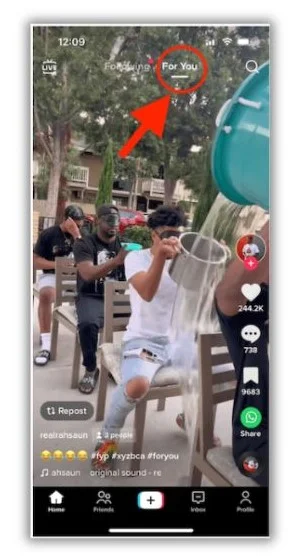
Everyone’s For You feed is unique and will change over time. TikTok pays attention to the videos you watch, where you post comments, and the accounts you follow. Each interaction is another signal the algorithm uses to refine your FYP—showing videos you’ll probably like while keeping videos you won’t off your feed.
💡 Want to grow all of your marketing channels? Download The Best Online Marketing Tips for Generating More Traffic, Leads, & Sales to get over 100 actionable growth marketing tactics.
How does the TikTok Algorithm work in 2024?
If you’ve ever sent your friend a cake recipe link because you remembered they love to bake, you get the gist of how the TikTok algorithm works.
Of course, TikTok’s proprietary algorithm is infinitely more complex than yours (no insult intended). It analyzes thousands of signals to determine which videos belong on your FYP. Let’s look at a few of the most influential ranking factors.
Factors TikTok uses to rank content
We’ll probably never know what every TikTok ranking factor is, but thanks to this post from TikTok itself, we do have an idea of a few ranking categories.
User interactions
Your behavior in the TikTok app is the most influential signal for the algorithm. Whenever you like a video or follow a particular account, TikTok uses that to understand your preferences further.
These are some of the user interaction signals TikTok will track:
- Watching full videos
- Following or hiding accounts
- Liking or sharing videos
- Commenting
- Reporting a video as inappropriate
- Adding videos to favorites
TikTok also uses what you say you are and aren’t interested in when you first join the app to guide its suggestions.
Other users’ interactions on a video can also determine whether you get it on your feed. If many people who share your interests watch and like a post, there’s a bigger chance you’ll see it, too.
Video information
On the flip side of the equation, TikTok reviews certain characteristics of the videos you’ve interacted with to see how they match your preferences. That’s important for creators to know since these are the things we have the most control over.
Here are a few of the video and post characteristics the algorithm looks for:
I’ll go into how to optimize your videos for TikTok marketing using these characteristics in a bit.
Device and settings
Device and settings are also user-specific actions the algorithm uses to recommend content. If you’re registered as a US user, you’ll see a lot more content made in the USA. But unlike user interactions, these are one-time signals that don’t typically change over time.
A few device and setting signals that may nudge the TikTok algorithm include:
- Language setting
- Country setting
- Device type
TikTok factor weighting
TikTok’s algorithm weights ranking factors based on how directly they indicate viewer preferences. Direct user actions, like watching a full video, carry much more influence than geographic location.
This means that while it’s good to be aware of all the ranking factors, your focus should be on posting content that your audience will want to watch and share.
Factors that don’t help (and could hurt) your content ranking
In its post, TikTok says it won’t give creators a boost based on past performance. Someone with a high follower count and previously viral videos won’t get preferential rankings over a smaller account with more relevant content.
Additionally, there are some types of content that TikTok will de-rank (show less or not at all) in your FYP. These include:
- Videos you’ve already seen
- Content that’s considered spam
- Duplicated content (like a second post of the same video)
- Videos with restricted content (like graphic medical procedures)
To be clear, some of this content will still be available if you search for it. It just won’t pop on your FYP.
How to reset the TikTok algorithm
TikTok’s algorithm finds the type of content you’ll love based mainly on what you’ve enjoyed in the past. Sometimes, the recommendations don’t keep up with your changing preferences, and your feed gets stale.
TikTok has built a way for you to scrub its algorithm so it starts from scratch. Then, your interactions moving forward will influence the content you get on your personal FYP.
Here are the steps to refresh your FYP:
- Open the TikTok app and tap “Profile”
- Go to the menu at the top and choose “Settings and privacy”
- Tap “Content preferences”
- Tap “Refresh your For You feed”
- Tap “Continue” and “Continue” again
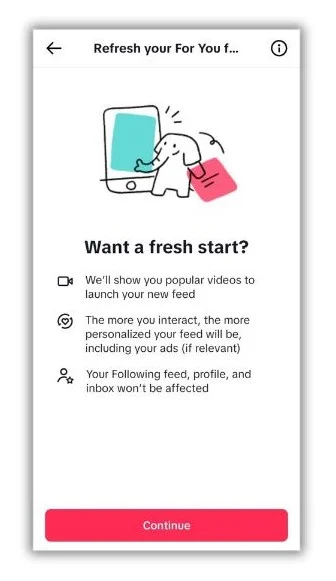

You can’t go back once you finish the process. But only your FYP will be affected. Your “Following” feed and profile won’t change.
📣 Free guide >>> 135 of the Best Words & Phrases for Marketing With Emotion
9 ways to use the TikTok algorithm to your advantage
Knowing how the TikTok algorithm works is half the battle. The other half is publishing engaging content that makes it easy for TikTok to find, categorize, and suggest your posts.
1. Hook viewers quickly
You have a fleeting second or two to grab a viewer’s attention and convince them to watch your video. Keep their thumbs from scrolling by adding an attention-grabbing hook that’s relevant to your audience.
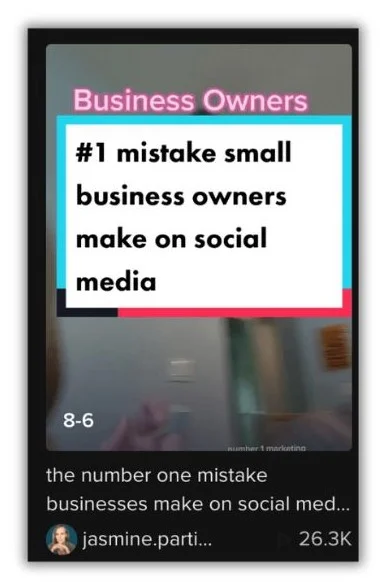

A great hook should give the viewer just enough information to make them want more. Try these tactics for your video hooks:
- Make a bold claim
- Ask a question
- Share a surprising fact
- Hint at a secret
Make sure each hook is relevant to your audience, and use emotional words to catch their attention.
2. Create niche content
It’s hard to gain footing with very popular topics on TikTok since many creators are already fighting for precious FYP placement. However, you can use the algorithm to your benefit by finding niche topics to post about.
For example, cooking is a super popular topic on TikTok. There are plenty of accounts dedicated to whipping up the best dishes. But Bobby Hicks of @theretrorecipekitchen uses his account to trial dishes from days of old. Many of the recipes he tests look tasty, while others look like…a veggie gelatin stack?


It may seem a little odd, but by focusing on one corner of a popular topic, Hicks has grown his account to over 150k followers.
Review the topics you’d like to use, and if they seem a little crowded, find a subtopic your audience would appreciate. That’ll leave you with fewer competitors in the race for the FYP. It’ll also make your content more relevant to a specific audience, which the algorithm loves.
3. Use TikTok SEO
Search engine optimization isn’t just for Google. Pretty much any time there’s a search function, you can optimize your content for it, and TikTok is no exception. Plus, even Google admits that TikTok is becoming a popular search engine in its own right.
In addition to the other tips in this guide, you’ll want to use keyword research to boost your TikTok SEO. Like on search engines, people use specific words and phrases in the search bar to find content on the app. Your job is to figure out what those words are.
Keyword research is easy on TikTok. Make a list of things your audience might search for that are relevant to your business. If you’re an esthetician, “skin care” might be one of them. Then, enter those words into the TikTok search bar and see what it auto-fills.
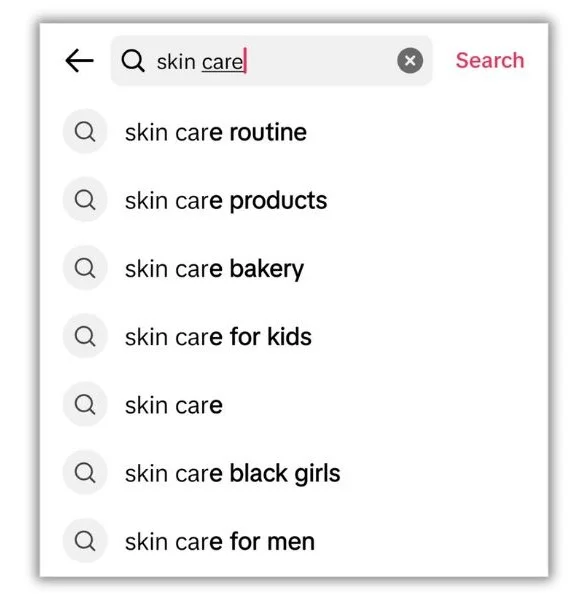

You’ll see options like “skin care for men” and “skin care routine.” Once you’ve gathered a list of keywords, plan out your content calendar to cover each term. Don’t forget to add keywords to your TikTok bio, too.
4. Tailor content to the platform
It’s smart to repurpose content for multiple platforms. But when it’s time to post it on TikTok, make sure it fits the app’s best practices.
First, produce and edit full-screen, vertical videos with a 9:16 ratio. That will fill the entire mobile screen while matching how most people view TikTok content.
Second, keep most of your videos short. While there’s no ideal duration for every video, in 2021, TikTok suggested that the optimal length should be 24 to 31 seconds. The platform has pushed for longer content, but many viewers find videos longer than one minute to be stressful, so it’s safer to keep them under 60 seconds.
Finally, for the best chance of your TikTok videos going viral, keep them positive in tone. Semrush evaluated a large collection of viral TikTok videos and found that those with a positive, funny, or happy vibe did best.
Follow these best practices to get more early engagement, which the algorithm will use as a signal that your video belongs on more FYPs.
5. Post at the right time and frequency
The TikTok algorithm doesn’t really care what time or how often you post—at least not directly. But it does look at how much engagement an individual video gets. Knowing when and how frequently to post can give your videos a little engagement boost.
The right time
The best time to post on TikTok depends on when most of your audience will be on the app. The goal is to publish content a little before the peak potential viewing time to get them indexed and ready for your followers.
You can find that information in your TikTok analytics.


The right frequency
Consistency is essential for success on any social media platform. You don’t want followers to forget about you, and you want more chances to reach new viewers. But how do you quantify “consistency?”
Just like timing, learning how often you should post on TikTok will take some trial and error. TikTok says you should post up to four times per day (of course they do). More realistically, most brands post content to TikTok around two to four times per week (depending on which study you follow).
Here are a few tips to find your perfect TikTok schedule:
- Consider your creative capacity: Posting more often is great, but not at the expense of quality.
- Review other creators: Spy on your competition to see how often successful accounts in your niche post content.
- Watch your analytics: Vary your posting frequency over several weeks and see how it affects your views and engagement.
6. Incorporate hashtags
Using hashtags on TikTok can help you succeed in two ways. First, hashtags help the TikTok algorithm understand your content so it can better match it to user preferences.
Second, TikTok users use hashtags to search for content, so when your video is tagged, it may show up in their search. As we know, when more people see your content, the algorithm will show it to more people with similar interests.
You can find which hashtags are trending in TikTok’s Creative Center.


Here are a few tips for using hashtags on TikTok:
- Don’t use too many: One to four hashtags will usually do the trick without making your post look spammy.
- Use different types: Combine branded, topical, popular, and niche hashtags for the best mix of reach and relevance.
- Include seasonal and holiday hashtags: Adding seasonal hashtags like #hellospring and #Holloweenscares lets you ride the wave of attention during peak times of the year.
7. Add popular audio clips
Audio clips work similarly to hashtags on TikTok. If an audio clip gets popular, and you like videos that use that clip, there’s a greater chance you’ll get more videos with that audio in your FYP.
Head back to the Creative Center to find trending songs.
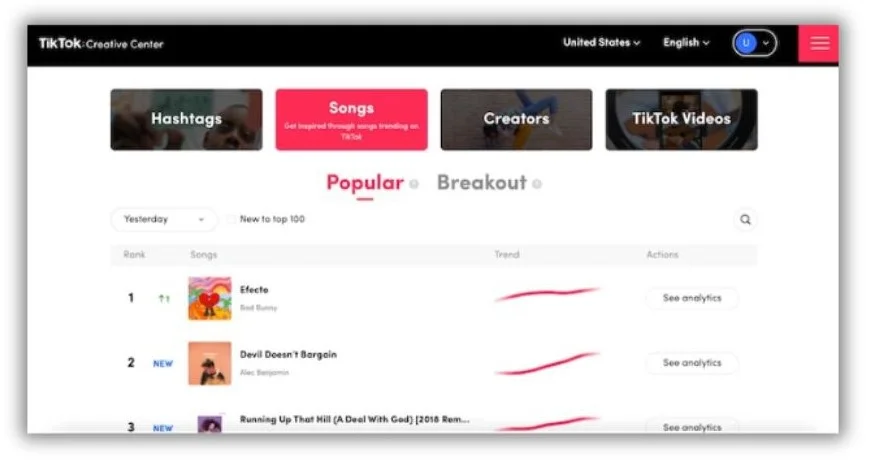

Look in the Popular tab to see which tunes are already getting a lot of play. Then, check out the Breakout tab to catch the next audio wave early.
8. Add captions
Many people don’t watch videos with the sound on. Adding captions to your posts lets those people follow along. But captions don’t just help you appeal to a broader audience. TikTok’s algorithm can learn more about your videos from the text of its caption.
TikTok makes it easy to add captions. Tap the Captions icon, and the app will automatically generate them.


Make sure you use the keywords you dug up in your video script. The algorithm will read those in the captions and know who should see your videos.
9. Jump on trends
One of the best ways to leverage the algorithm to get views is by following TikTok trends. A trend is a theme, idea, or trait of a video that already has mass appeal. That might be a common song or a dance.
Trends can also be challenges, like this one where one person holds another so they look like they’re in the iconic scene from the movie Titanic.


When viewers get hooked on a trend, TikTok sends them more videos to view. If you’ve jumped on the trend, the algorithm will put your video in that mix.
Work with the TikTok algorithm to go viral
The trick to social media marketing is remembering that social platforms want you to succeed. If people love the content you post, they’ll spend more time on the app—which is a win-win for everyone.
The key is learning how the TikTok algorithm works to make it your partner in success. Instead of fighting against the algorithm, find ways to leverage it, and you’ll leap-frog ahead of all the accounts trying to trick or hack it.
Here’s a recap of nine ways you can use TikTok’s algorithm to your advantage:
- Hook viewers quickly
- Create niche content
- Use TikTok SEO
- Tailor content to the platform
- Post at the right time and frequency
- Incorporate hashtags
- Add popular audio clips
- Add captions
- Jump on trends
PPC
How to Brainstorm Business Ideas: 9 Fool-Proof Approaches

There are 33 million small businesses in the US alone, and 5.5 million new businesses are started every year. And yet, the beauty of this ever-growing world is that there’s always room for one more business. So if you aspire to start a business, we support you!
And if you need a little help with ideas and planning, you’re in the right place. In this article, we’re sharing nine ways to brainstorm business ideas to help get you off on the right path.
Contents
- The problem-solving approach
- The personal inventory approach
- The market research approach
- The competitive analysis approach
- The business name approach
- The influencer approach
- The networking approach
- The freelance website approach
- The Gen Z approach
How to brainstorm business ideas: 9 ways
The best part about brainstorming is that there doesn’t have to be a formal process. You can use one of these approaches or a combination of any of them. The goal is to get the juices flowing and see where they take you!
1. The problem-solving approach
This approach is centered around pain points. Put your pain point glasses on for a day and pay attention to every little thing that you find even the slightest bit inconvenient, cumbersome, challenging, boring—basically any negative adjective you can think of. Then brainstorm ways you can solve those problems. The more common the task, the better, because the greater the need.
For some inspiration, check out these creative products you never knew you needed by Lifehack.
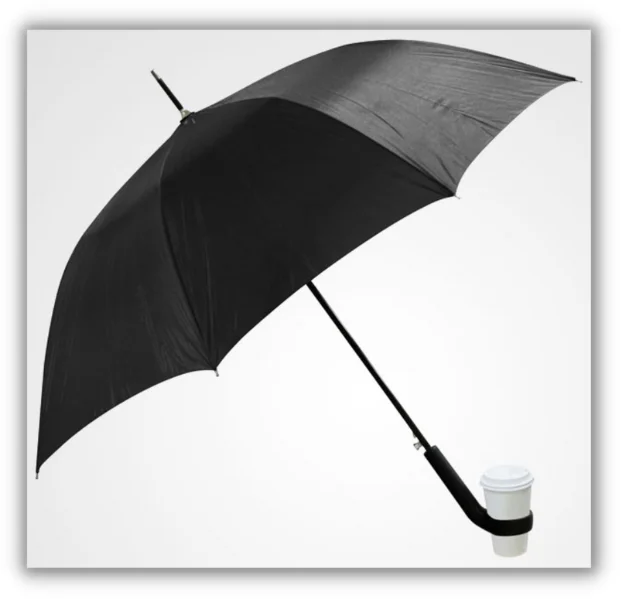
An umbrella cupholder? I’d buy one.
💡 Once you’ve identified your business idea, you need a strong value proposition. Learn how to create one in our free guide >> How to Create a Unique Value Proposition From the Ground Up
2. The personal inventory approach
This is the tried-and-true approach to coming up with small business ideas. Take a personal inventory of what comes naturally to you. Consider:
- Your passions: Things you care about
- Your core values: Standards you live by
- Your best skills: What you’ve become good at with practice
- Your talents: What you’re naturally good at without any practice
- Your hobbies: Things you could do all day
List these out and see what kinds of ideas arise from them. I personally recommend this as the top way to brainstorm business ideas, because the more aligned your business is with your core self, the less friction you’ll experience in starting, running, and growing it.


There are several ways to map out your personal inventory, like this one.
3. The market research approach
This is the more practical approach to take when brainstorming business ideas, and one you should incorporate into any of the other approaches. After all, you need to make sure you can actually go to market with your idea and be positioned for long-term success.
Consider industry trends, emerging technologies, and consumer behavior so you can get an idea of the competitive landscape, identify unmet needs, discover niche audiences, and more. Market research encompasses a broad range of strategies, including surveys, social media listening, reading research reports and surveys, using market intelligence tools, and more.
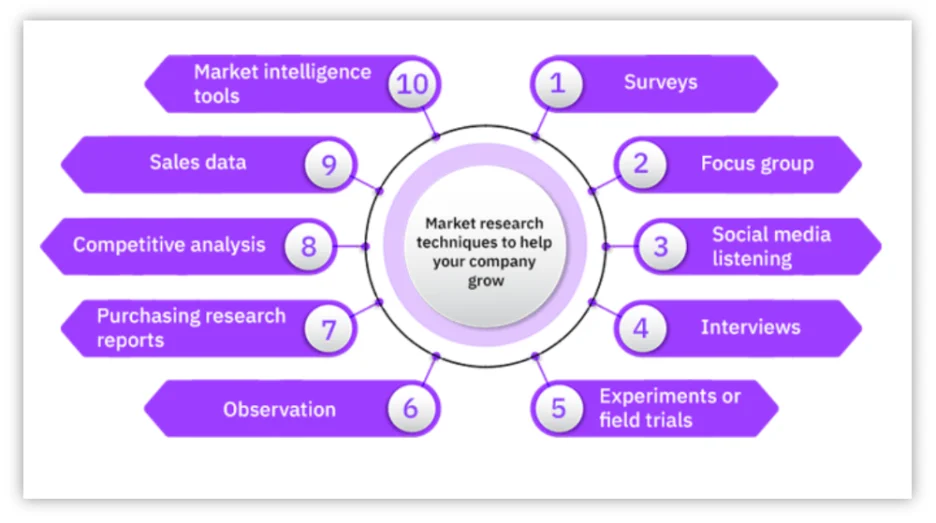

📚 Free guide download >> 135 of the Best Words & Phrases for Marketing with Emotion
4. The competitive analysis approach
Competitive analysis technically falls under market research, but these are so effective that they’re worth calling out as their own approach. In short, a competitive analysis systematically examines the key components of other businesses like yours so you can identify gaps to fill and how to best position yourself. You can look at strengths, opportunities, weaknesses, and threats (SWOT analysis) or use any other criteria that works for you.
This approach is great for once you’ve got a clear picture of the type of business you want to start but want more guidance on coming up with the details of that business (like your target audience, buyer personas, value proposition, etc.).


For help with this, use our competitive analysis templates!
5. The business name approach
This, of course, should not be your only approach, but it’s a good strategy to throw in when you need a break from all that market research. Creative business names can give way to creative business ideas, and vice versa.
Do a business naming brainstorm session—use our list of creative business names to start! Just remember, there’s a practical process for naming a business, so be sure to check out our post on how to come up with a business name so you can be prepared.
6. The influencer approach
The right way to come up with a new business idea depends on what’s driving you to start a business in the first place. And if it’s simply that you have an entrepreneurial itch, but no prior experience, then take the time to expose yourself to some entrepreneurial inspo!
Read books written by entrepreneurs, listen to small business podcasts, and start following inspirational business owners on social media. You’ll open yourself up to a wide range of concepts, perspectives, approaches, and mindsets that can give way to great business ideas.
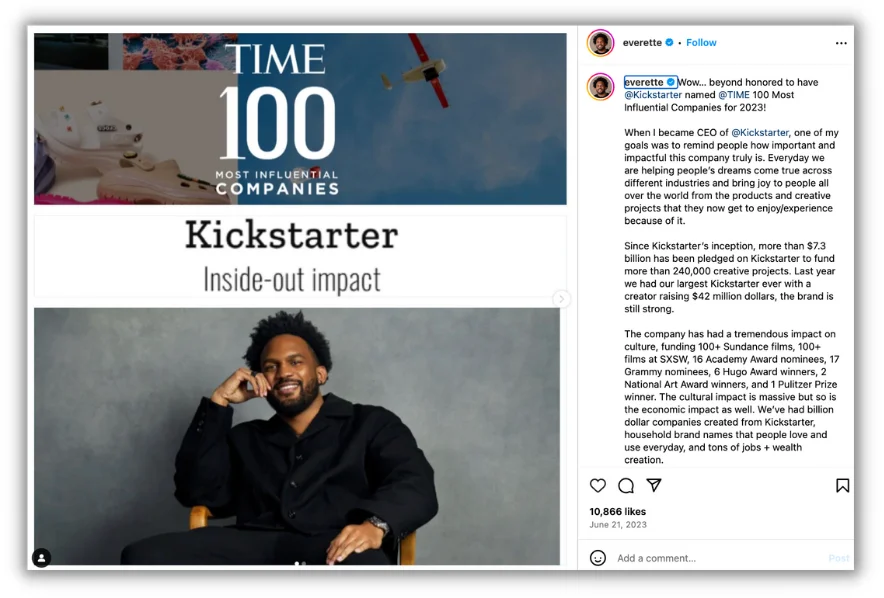

Everett Taylor is one of many inspirational entrepreneurs you can follow on social media.
7. The networking approach
In addition to following popular entrepreneurs on social media, it’s also a good idea to network with “regular” entrepreneurs. The influencers can provide inspiration but talking with people just like you will give you an added level of practicality to your ideation process.
Find networking events and discussions happening in your local community and even virtually. Here are some broader small business networking groups to start with.


SCORE is a great place to find local networking events in your area.
8. The freelance website approach
Who says your new business has to be unique? If you’re looking to start a freelance business, take a look at popular websites like fiverr and Upwork. You can find business ideas that use skills and talents you already have, or ideas that require you to develop new skills to reach growing markets.
For example, take a look at fiverr. The navigation menu and “popular services” section alone can give you a starting point from which to generate ideas.
- Website development
- Logo design
- SEO
- Architecture and interior design
- Social media marketing


fiverr’s homepage alone is filled with business ideas based on demand or skillset.
9. The Generation Z approach
Generation Z is the upcoming generation of consumers, and they are known for being partial to brands that name specific core values and stand for them. If you’ve got a cause you personally care about or specific set of values that you live by, let this serve as the foundation of your business idea.
Examples include sustainability, civil rights, individuality, accessibility, and more. Similar to the personal inventory approach, starting a business out of something you’re personally connected to tends to reduce friction throughout the business’s evolution. Check out our post on Gen Z marketing strategies to see if you have anything in common with them!
Start brainstorming business ideas now
Like I said at the start, even with so many businesses already up and running, the world is always growing and changing. Its many facets—consumer needs, industry trends, personal passions, and more—form a dynamic ecosystem that is always producing opportunities. Use the tips in this post to brainstorm business ideas that align with these opportunities!
PPC
How to Craft Compelling Google Ads for eCommerce

Many of those involved in PPC tend to be the data geeks. That means we often focus more on impression share ratios, target ROAS, and search queries than the creative side of advertising. With Google doing more and more of the heavy data lifting, marketers need to understand that the two things AI and machine learning struggles to replicate are creativity, and a deep understanding of our customers.
High CTRs, alongside highly relevant ad copy, are rewarded with higher quality scores which leading to lower cost per clicks. Lower CPCs are ever more important as the barrier to entry to setting up an ecommerce business is the lowest it’s ever been (and getting lower), especially with the rise of Shopify.
To stand out from the crowd, you need to present a real, tangible differentiation in the market place. Which means you need to be creative with your copy.
Media buyers will often talk about selling points and how you have to showcase your benefits within the ad copy. Ecommerce PPC has 3 core ad copy pillars that the sale hinges on:
1. Your Site
2. Your Product
3. Your Offers
The below highlights some examples in more detail:
Ecommerce Site Selling Points
- Free Delivery Over X: This is a strong incentive for customers to increase their basket size.
- Over 300 5-Star Reviews: Having over 300 5-star reviews demonstrates that you are trusted and have a proven track record of looking after your customers.
- Exclusive To Us: Offering products exclusive to one’s site can create a sense of uniqueness and urgency
- Each Order Donates £1 To Charity: Incorporating charity into each order by donating a fixed amount portrays the brand as socially responsible. This can resonate well with socially conscious consumers.
- Secure Payment: Security in payment processes reassures customers against fraud, leading to increased conversions.
- Fast & Free 2 Day Delivery: Fast and free 2-day delivery appeals to the immediate gratification desire of shoppers.
- 30 Day No Hassle Returns: A 30-day no-hassle return policy reduces the perceived risk of purchasing and encourages trying out new products.
Product Selling Points
- UK Made: Products made in the UK appeal to a sense of national pride and suggest a certain quality
- 31% More Powerful / Finished in 10 Minutes: An item being 31% more powerful or promising completion of tasks in 10 minutes conveys efficiency and value.
- As Seen in Vogue, Cosmopolitan: Having products featured in reputable magazines like Vogue or Cosmopolitan can significantly bolster brand prestige. Where have you have been featured? Can you lean on this angle?
- Made With Bamboo, Cotton, Sustainable / Recyclable: Products made with sustainable materials like bamboo and cotton can appeal to environmentally conscious consumers. Offering recyclable packaging can further enhance the eco-friendly image of a brand. Think about what is currently trending. If you’re a socially conscious brand it will always be worth highlighting.
Types Of Ecommerce Offers
- 20% Off With Code HERES20: A 20% discount using a specific code such can be a direct call to action that stimulates sales. Better to use sparingly otherwise you may end up losing brand equity.
- Spend £100 to get £10 Off: Encouraging customers to spend more to receive a £10 discount can effectively increase average order value. This can especially work well with tiered offers.
- Buy 1 Get 1 Free: A ‘Buy 1 Get 1 Free’ deals can double the perceived value for a customer, making it a compelling offer. Often works well on lower aov items.
- Free Delivery: Offering free delivery, regardless of the purchase amount, is always a powerful motivator for customers to complete a purchase. It’s often the easiest to implement.
- Free Gift With Order: If you sell products that complement free gifts you should make the most of them. Some brands employ this tactic as an ongoing incentive, as it works especially well if the gift is also sold on site for a lower price.
- New Customer Offer: 10% off for new customers only is a common but effective offer for ecommerce. This is good for more established brands that don’t want to lose margin on previous customers who were planning to buy anyway.
How To Know Which Copy to Use?
Knowing what your customers want is 99% of the battle to achieving higher quality scores, clickthrough rates, and even conversion rates as you raise their buying temperature. Your copy should reflect who your audience is, and what they need from you. You also need to factor in the following when crafting copy that is going to resonate:
- Demographics: Age, gender, income, occupation, education
- Psychographics: Personal values, beliefs, interests, lifestyle
- Identifying Pain Points: Feedback, surveys, market research, reviews, analytics
Ad copy should align with the search intent of the audience, which can range from informational queries to transactional searches. You can uncover this through the initial stages of keyword research. It’s best practice to group your keywords by their intent.
Here’s how keywords are often segmented:
- Informational – e.g. what are the benefits of aloe vera for skincare?
- Competitor/Navigational – e.g. the body shop
- Transactional e.g. Aloe Soothing Day Cream 50ml
This should get you thinking deeper about how to position your ad copy and all the angles you can take. Start with a blank spreadsheet with 3x columns and write down 5-10 points across site selling points, product and offers you can implement.
Amore Digital is a boutique Google Ads Agency that has a mix of ecommerce clients from pet, fashion, automotive, healthcare and more. We provide a specialist service with Google Shopping, Feed management, Pmax management and search marketing consultancy.
-
SEARCHENGINES5 days ago
Daily Search Forum Recap: May 3, 2024
-

 MARKETING6 days ago
MARKETING6 days agoLet’s Start Treating Content More Like We Treat Code
-

 MARKETING4 days ago
MARKETING4 days agoHow Tagging Strategies Transform Marketing Campaigns
-

 MARKETING5 days ago
MARKETING5 days agoTinuiti Recognized in Forrester Report for Media Management Excellence
-

 WORDPRESS6 days ago
WORDPRESS6 days agoThe Top 5 AI-Powered Tools for WordPress Creatives – WordPress.com News
-

 SEO5 days ago
SEO5 days agoGoogle Performance Max For Marketplaces: Advertise Without A Website
-

 SEO7 days ago
SEO7 days agoGoogle’s Search Engine Market Share Drops As Competitors’ Grows
-

 PPC7 days ago
PPC7 days agoMarketing Funnel: Stages, Strategies, & How It Works















